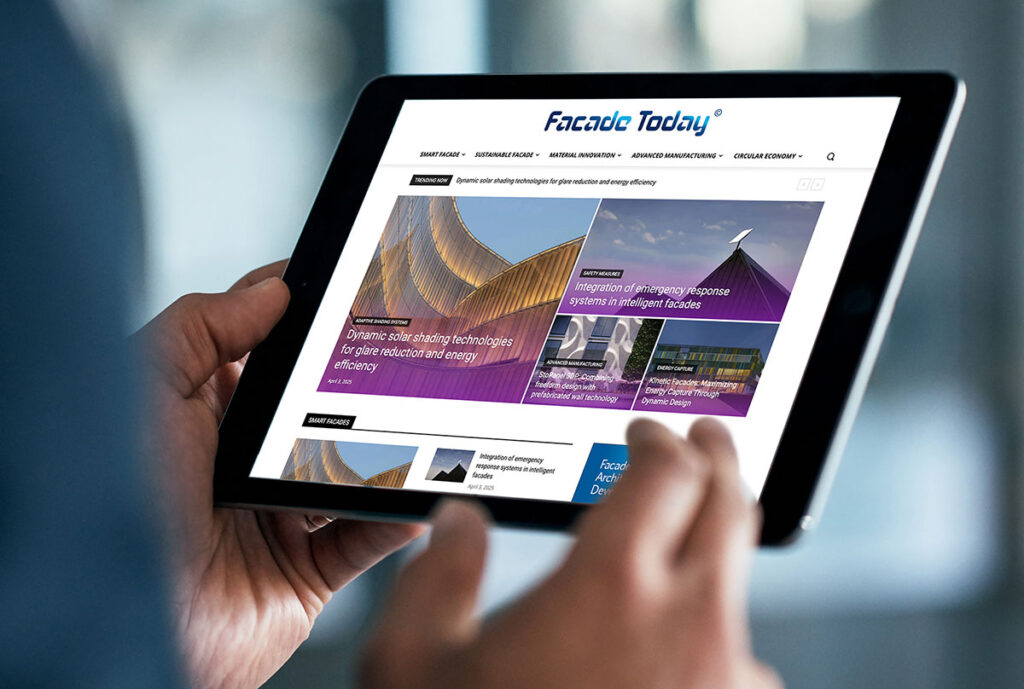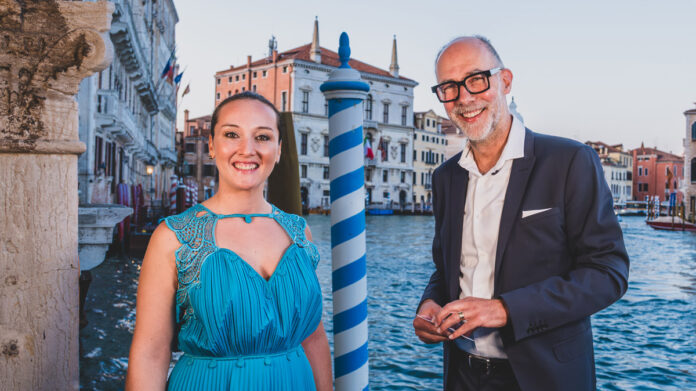As the third edition of the Performance-Based Façade Design (PBFD) conference unfolded in Venice, a city balancing ancient beauty and technical evolution, façade engineers, architects, and building developers were brought together to exchange fresh perspectives on the future of the envelope. PBFD’s 2025 edition carried a resonant theme: the merging of advanced technologies and natural elements in pursuit of sustainable building envelopes. With innovation, experimentation, and collaboration at the core, the event stood as a showcase for ideas, tools, and leadership that are redefining what makes a high-performance façade. Olivier Dupuis, founder and editor of Facade Today sat down with leading voices for a series of in-depth interviews: Angela Mejorin (PBFD Founder and Curator), Vivian Manasc (Reimagine Architects), Saul Papaleo (AGC Glass Europe), Agnes Koltay (Koltay Facades), Frank Maas (Edge Technologies), Andrea Hellerman and Michele Assebese (Wiss, Janney, Elstner Associates – WJE). Their insights illuminate the power of cross-disciplinary exchange, exploring lessons learned and key strategies from the front lines of complex envelope projects worldwide.
Angela Mejorin on Challenges and Opportunities in Facade Design (PBFD Venice)
Angela Mejorin, founder and curator of Performance-Based Facade Design, set the tone in an interview that underscored her passion for technological advancement rooted in the unique context of Venice. Born and raised in the city, Angela Mejorin started PBFD after a period in Canada, partly as a way to reconnect with her hometown and spark dialogue amid the delicate setting of Venice each September.
Angela Mejorin sees climate change as the defining challenge for façade professionals today. She described building envelopes as “the first barrier,” with material choices and innovative systems playing a pivotal role in both resilience and sustainability. She stressed that progress hinges on bridging political, environmental, and technical issues, emphasizing durability as a key concern: “It’s interesting to notice that facades, they are designed for 50 years, but here [in Venice] they have been sitting for much longer.” The gap between the durability of traditional architectural environments and modern material lifespans, she argued, demands a rethinking of technology and planning.
Standardization is another driving force for Angela Mejorin, who emphasized its role in translating research into real-world practice. Having led an ISO standardization project published in 2024, she now collaborates with ASTM to develop new testing for wind-induced noise, ensuring that facade innovation translates into improved post-occupancy outcomes. For Angela Mejorin, PBFD’s multidisciplinary, international audience, from engineers and architects to digital product designers and academics, creates an inspiring hub for such discoveries.
Reimagining Place, Building for Community, Designing with Empathy: Vivian Manasc’s Lessons from Canada’s North (Reimagine Architects)
Vivian Manasc, Principal at Reimagine Architects (Alberta, Canada), offers a perspective shaped by decades of climate-responsive practice in North America and experience reimagining existing buildings. Her transnational background – from Romania to Montreal and then western Canada – reflects the global, hybrid energy of the event.
Vivian Manasc highlighted the importance of designing for extreme climates, ranging from Arctic cold to soaring heat, as climate change drives unprecedented weather volatility. One of her key points was the need for affordable, high-performance envelopes: “The economics of high-performance sustainable buildings is increasingly complex,” she observed, especially for retrofit of building stock from the 1970s and 80s. She considers the reuse and upcycling of existing buildings a complex but urgent challenge for the sector.
For Vivian Manasc, the PBFD conference was an opportunity to build networks crucial for lifelong learning. Bringing together architects, engineers, scientists, manufacturers, and developers from as many as 16 countries, she stressed that “skills and knowledge are resonant within individuals,” and that the relationships built in moments like PBFD are vital to career-long problem-solving. Her advice to the next generation: “Imagine the world of the possible… There’s always a solution. You just have to keep exploring, and keep building your network of people who can help solve those problems.”
Driving Materials Innovation for a Circular Future: Saul Papaleo (AGC Glass Europe)
Representing the manufacturing side, Saul Papaleo, Head of International Building Projects at AGC Glass Europe, explained how his company is driving innovation and circularity in facade glass. A longtime leader of AGC, Saul Papaleo linked the company’s ambitious sustainability targets (30% emissions reduction by 2030, net zero by 2050) with on-the-ground investments like the “Volta” pilot furnace. This pioneering initiative uses a 50/50 mix of electricity and fuel, aiming to move low-carbon and circular glass production from proof-of-concept to market scale.
Saul Papaleo described the rollout of AGC’s low carbon glass and, notably, an Environmental Product Declaration (EPD) configurator for custom double glazing units, offering facade professionals precise data on embodied carbon per composition. With custom-certified EPDs for each project, AGC empowers designers and engineers to set and verify ambitious sustainability benchmarks.
Digitalization, Saul Papaleo argued, is as crucial as new materials: “It is the connection between the company, manufacturer, and customer.” AGC’s online configurator and digital tools offer architects not only technical data but also insight into product selection, acoustics, and environmental performance. Of particular note is the rise of vacuum glazing: AGC’s Fineo line offers lighter, low-CO₂ glass for facades, provided designers integrate these advanced products into the design from the outset.
Saul Papaleo concluded that PBFD is the ideal forum to exchange and develop such “technological and advanced solutions,” thanks to its culture of shared learning and innovation.
The Engineer’s Perspective: Technical Rigor, Creativity, and Early Involvement with Agnes Koltay (Koltay Facades)
Agnes Koltay, CEO at Koltay Facades, presents a perspective that bridges vision and execution. For Agnes Koltay, the foundation of a successful façade is laid early, when engineers join the team as soon as the massing, function, and architectural direction are defined. “We like to collaborate when it’s early enough, before the structure is set. That way, we can work with the architectural and structural teams to harmonize ambitions, share knowledge, and drive efficiency,” Agnes Koltay explains.
She describes performance as multifaceted: for architects, it’s aesthetics; for occupants, comfort; for developers, everything from cost to constructability. The engineer is often the mediator, reconciling these sometimes conflicting drivers to deliver a “well-performing” solution. Agnes Koltay’s work, particularly on technically challenging projects such as recent large-scale cast glass façades in harsh climates, demonstrates the critical value of hands-on research, robust testing, and active collaboration with all project actors. Continuous involvement through design brainstorming, prototyping, and construction oversight ensures that ambitious architectural ideas are realized without compromising durability or performance.
“Some of the most successful projects are those,” she notes, “where the technical team helps the competition team overcome real or perceived limits, advising on new ways to use old materials, or turning constraints into drivers for innovation. Continuous dialogue makes it possible.”
Developer Perspectives: Frank Maas on Value, Retrofit, and the Future Workplace (EDGE Technologies)
Frank Maas, Director Concepts & Acquisitions at EDGE Technologies and member of the PBFD advisory board, brings a distinctive viewpoint as real estate developer at Edge Technologies in Amsterdam, renowned for sustainable and technology-driven buildings. During the interview, Frank Maas emphasized how his dual background allows him to bridge creativity, technical innovation, and the investment realities shaping façade decision-making.
He highlighted a crucial and often overlooked challenge in facade engineering: aligning design ambition with owner priorities of value creation and preservation. Drawing on years of experience, Maas noted, “Engineers and architects are fully invested in creating their vision and materializing ambitions, but we also need to match feasibility and investor expectations.” For Frank Maas, successful façade upgrade or retrofit must account for technical longevity, aesthetics, and energy performance in tandem; failure to do so risks creating “stranded” buildings that are stylistically outdated or too costly to revitalize.
Frank Maas also discussed the evolving definition of the modern workplace. At Edge Technologies, the workplace itself is treated as a “testing ground laboratory” for new ways of working, comfort, and user experience. His goal: to craft environments that are more desirable than being at home, drawing people together to exchange ideas and innovate for years to come.
All these insights underscore a recurring PBFD 2025 theme: true progress requires creative collaboration across disciplines, a rigorous business mindset, and constant adaptation to how people want to live and work in the future.
The Consultant’s View: Andrea Hellerman and Michele Assabese on Bridging Global Codes and Quantifiable Collaboration (WJE)
Andrea Hellerman and Michele Assabese, both associate directors at Wiss, Janney, Elstner Associates (WJE), also embody this multidisciplinary spirit. With backgrounds spanning architecture, engineering, and consulting across multiple countries, they see the evolution of façade practice as increasingly evidence-based and data-driven, spurred by a “performance-based” mindset.
“International work exposes you to vastly different codes,” Andrea observes, “and if we want out-of-the-box solutions, we need research, simulation, and rigorous testing, both in the lab and field. You can give designers more freedom by proving their concepts with data.” Michele adds that early-stage collaboration is essential, allowing teams to identify risks and avoid excessive conservatism in design margins. “As requirements grow more stringent and sometimes conflicting, the only way is to be detailed and coordinated from the outset.”
Both consultants highlight that modern tools empower project teams to unite ambition with practicality, advanced simulation, digital prototyping, and first-principles thinking all support non-standard solutions while maintaining compliance and safety. Yet, installation remains the crucial final step. “No matter how brilliant a simulation, the final result depends on careful, informed execution on site. A strong feedback loop between design and construction is vital,” Andrea notes.
Shared Lessons: Inspiration, Humility, and Moving Forward Together
Earlier in the day, Daniel Lemieux (Principal and Director for Wiss, Janney, Elstner Associates, Inc. and Wiss, Janney, Elstner Limited, London) stressed that performance-based design is a powerful catalyst for innovation and sharper risk management in façade design. “When we embrace outcome-based design, we drive innovation, but must always be wary of new, untested products and materials,” Lemieux observed. “When new, innovative and yet untested products with no track record are rushed to market, we have an obligation as design and construction professionals to manage that risk.” For Lemieux, “sustainable design is not about awards or plaques on the wall. It is about durability and the ability to deliver, rather than simply promise, quantifiable performance.” And his advice for the next generation? “Be fearless in your search for knowledge, never accept anything at face-value, and always bring a first-principles approach to problem-solving.”
As the sector continues its phase of experimentation, all interviews show that resilience, circularity, and full-spectrum collaboration are the keys to creating the next generation of facades with unparalleled identity. The future of the envelope is not just high-tech; it is deeply human, made possible by the sharing of knowledge and an unwavering commitment to progress.
https://www.performancebasedfacadedesign.org
This article concludes our four-part series on PBFD 2025, where Facade Today was honored to serve as media partner. Our goal throughout this series was to capture the conference’s essence and highlight its most relevant messages for facade industry professionals.
During PBFD 2025, presenters truly pushed the boundaries of what’s possible, from advancements in bent glass and bio-based materials to powerful data-driven strategies like façade analytics and futureproofing. Behind these achievements was the deep collaboration taking place across disciplines, throughout the project lifecycle, and among a diverse, global community. Every voice emphasized the value of a team culture open to challenge, honest dialogue, and rigorous testing of each new idea.
The takeaway is clear: in today’s complex field, close daily collaboration between technical and creative minds is critical.
Facade Today is proud to have supported this important event. We will continue to share insights and inspiration from the teams pioneering the next era of resilient, beautiful, and high-performance building envelopes.
Facade Today was Media Partner of Performance-Based Facade Design 2025.
As part of this partnership, Facade Today supported the event with editorial coverage, digital visibility, and content amplification, helping ideas travel further across the facade engineering and architecture community.
Are you organizing an event related to façade design, smart materials, sustainable construction, or architectural innovation?
Let’s talk! We’re always open to media partnerships that align with our editorial mission and bring value to our readers.
Reach out to us at editor@facadetoday.com
We’d love to hear about your event.

As the Editor of FacadeToday.com, I merge my passion for Design, Architecture and Technologies with three decade of experience collaborating with entrepreneurs across many industries. My career has centered on fostering innovation, scaling business opportunities, and bridging gaps between technical experts, business developers, and creative visionaries. I thrive at the intersection of sustainable solutions, material advancements, and smart technologies, curating insights on themes like energy-efficient facades, smart tech, and advanced manufacturing. With a commitment to lifelong learning, I aim to empower architects and facade engineers by translating innovations into actionable knowledge, driving the industry forward through purposeful connectivity and cutting-edge practices.



